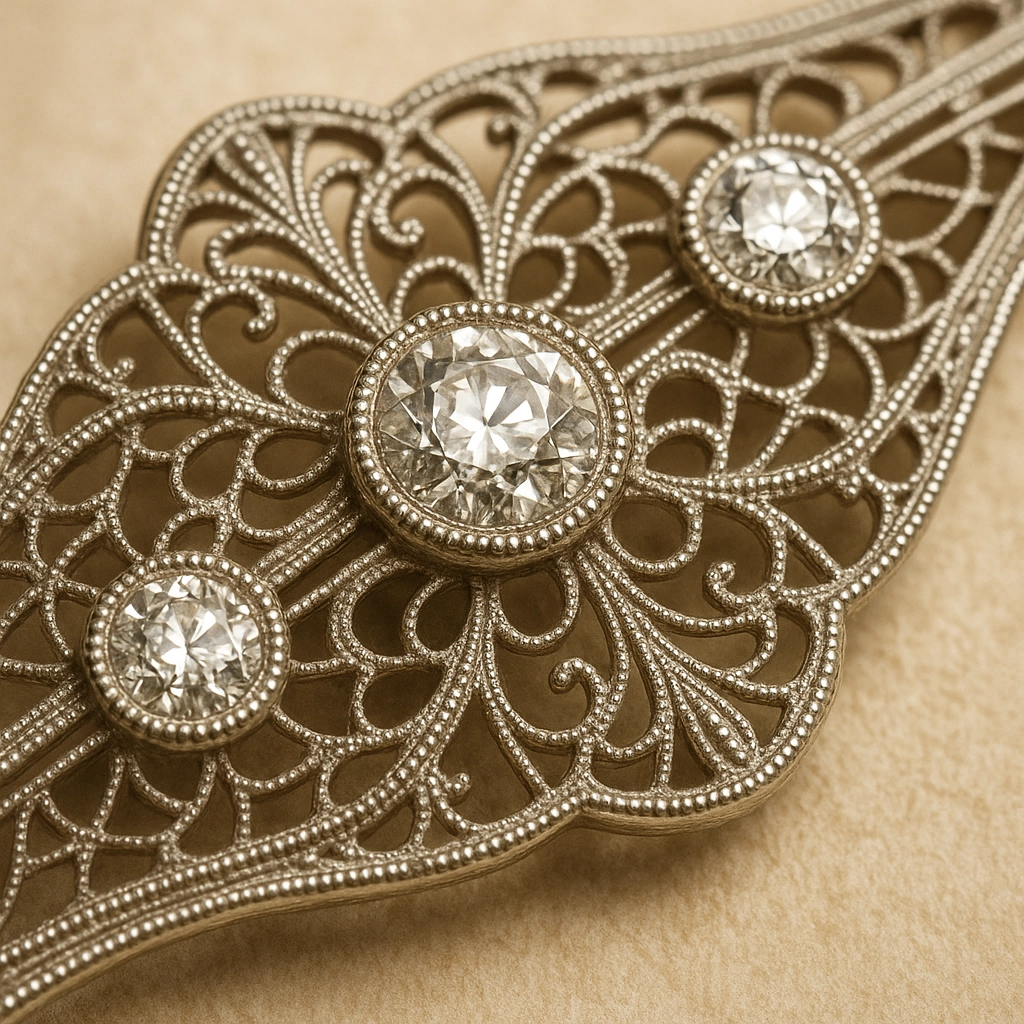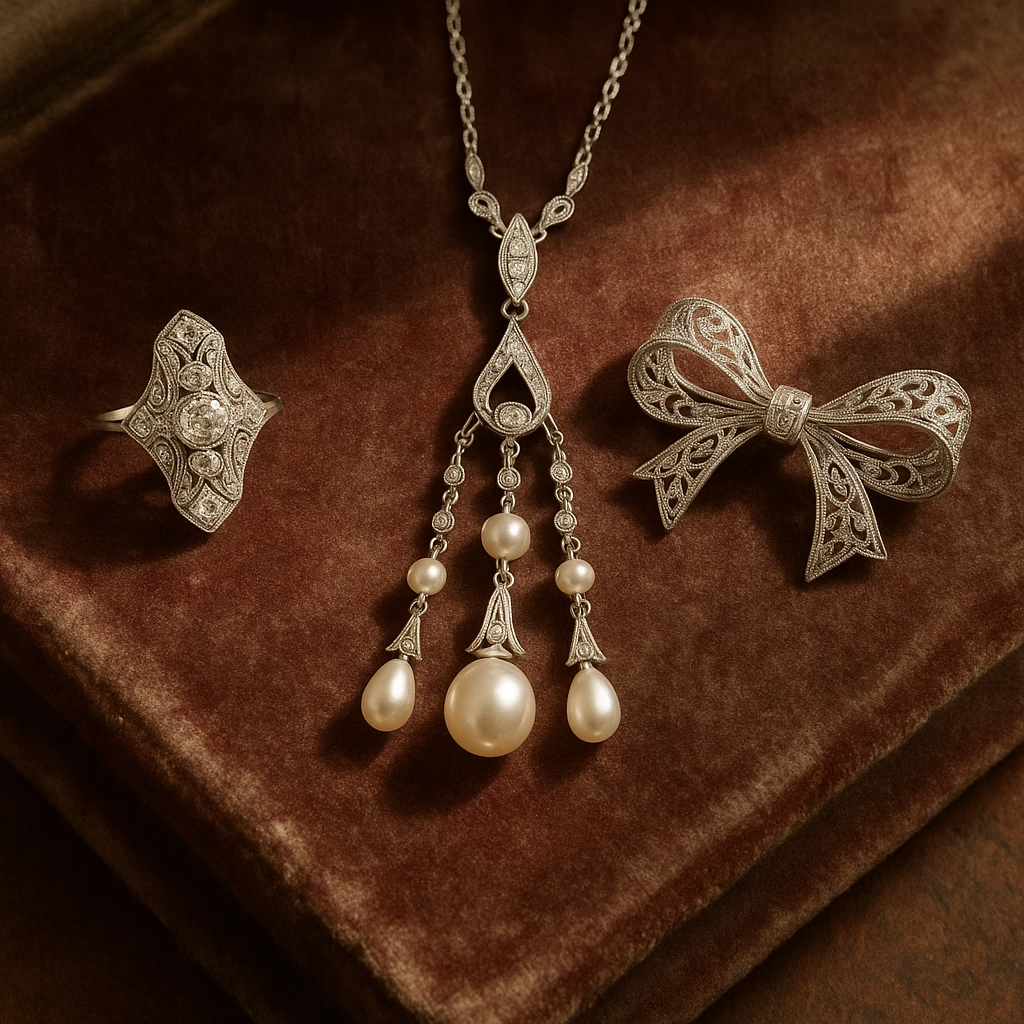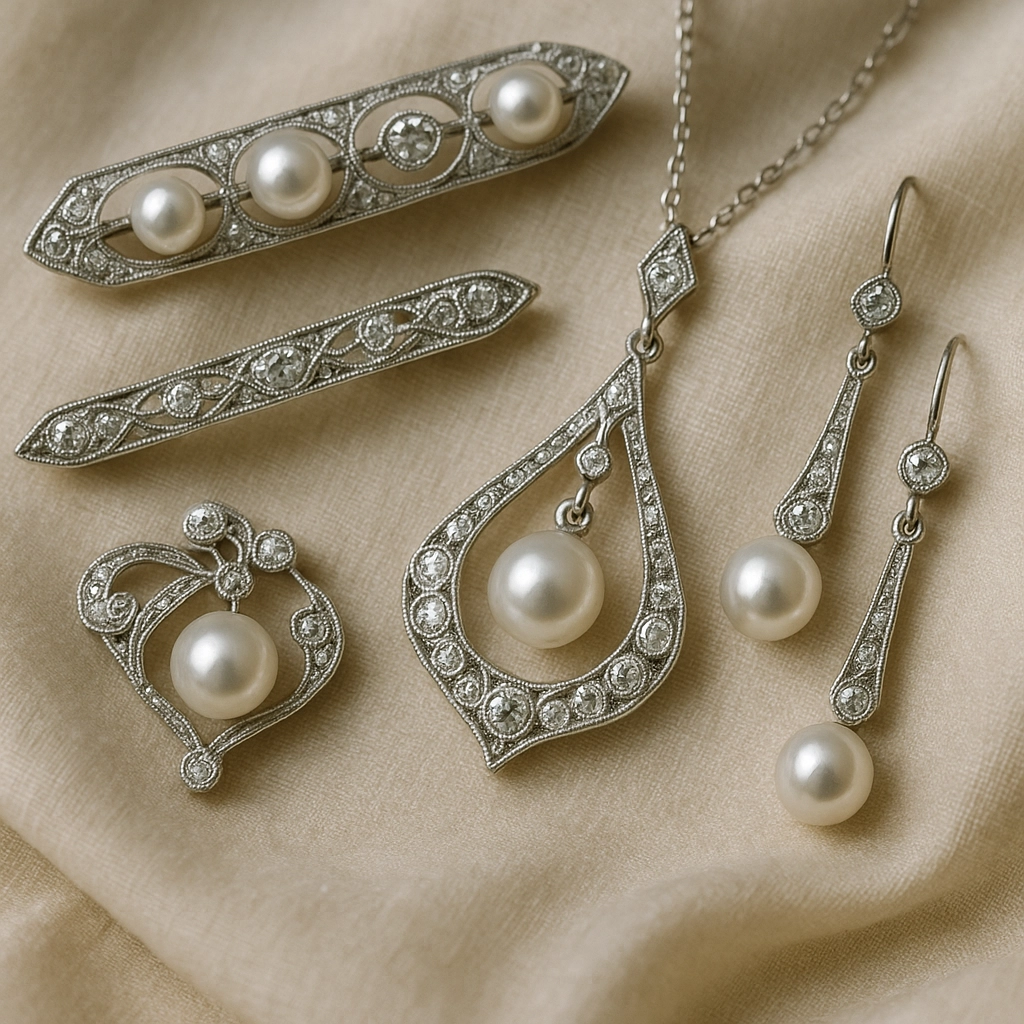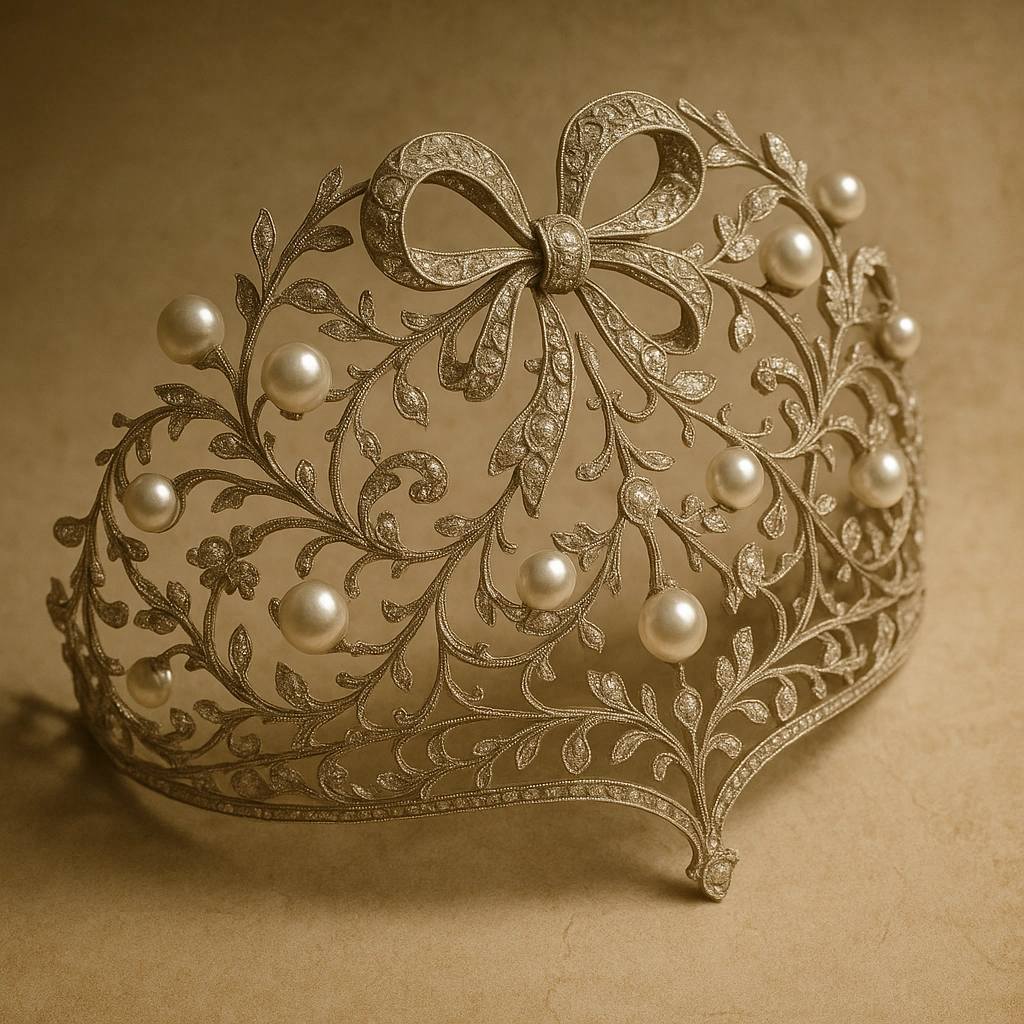Edwardian Mastery: The Techniques & Materials that Changed Jewelry Forever
The Edwardian era (1901-1914) was a straight-up game-changer for jewelry: it took what was heavy and dark in the Victorian years and spun it into something light, clever, and impossibly elegant. When I look at Edwardian pieces, I can’t help but marvel at how the jewelers of that time pushed the limits of their craft. This post is all about how they did it: platinum’s arrival, the mesmerizing handiwork of filigree and millegrain, diamonds and pearls as you’ve never seen them before, and even the hidden engineering behind what look like mere adornments.
Platinum: The Metal That Changed Everything
When you pick up a piece of Edwardian jewelry, notice how the settings are so unbelievably thin: like the metal is holding its breath, letting the gems shine. That wasn’t possible in the 1800s. The secret? Platinum.
Before Edwardian times, gold and silver ruled jewelry design, but both had limitations. Then came platinum. Platinum isn’t just beautiful: it’s tough as nails (well, for a precious metal). Jewelers were finally able to make super fine, lacy settings, creating that airy, floating effect Edwardian work is famous for. In fact, what Cartier dubbed the "white on white" look: platinum with diamonds and pearls: became a signature of high fashion until about 1914.
At first, folks didn’t even believe platinum deserved star billing, so some pieces had gold underneath for ‘status points’. By the early 1900s, though, jewelers ditched the gold, and platinum reigned supreme. Suddenly, intricate designs that would have bent or broken in gold became possible and durable. That’s how you get those diamonds arranged like delicate snowflakes rather than chunky clusters.
Revolutionary Techniques: Millegrain, Filigree, and More
Take a closer peek (maybe with a loupe next time you’re in a jewelry shop) and check out the edgework: see the tiny beaded borders wrapping around gemstones? That’s millegrain, and it became an Edwardian signature. Made possible by platinum’s strength, millegrain adds a soft shimmer and texture that gives even the smallest detail a finished look. If you ever wondered why Edwardian rings and brooches look so “complete,” millegrain is a big reason why.

Equally jaw-dropping is filigree work: all those fanciful threads and metal beads twisted into intricate, flowing patterns. Pre-Edwardian filigree could be clunky, but platinum let jewelers make their lines as fine as a hair. The effect? A lattice of metal that looks as if it might float away.
And then there’s something you might not spot at first glance: invisible settings. These let diamonds and gems appear to almost float, set so expertly that supporting metal simply vanishes to the naked eye. The result is airy, sophisticated, and a little mind-boggling. For anyone who loves the idea of “diamonds on skin,” this trend started right here.
Let’s not forget pierced work: jewelers literally cut patterns straight through the metal, creating shadow and light in every glance. Add millegrain and filigree to those open spaces, and you get jewelry that’s more like miniature architecture than mere ornament.
A New Philosophy: Handcrafting Over Mass Production
Edwardian jewelers looked back at the handmade traditions of the 18th century but had a modern twist: instead of churned-out pieces, each jewel became a canvas for technical skill and artistic imagination.
If you compare Edwardian jewelry to what came before, it’s almost like the difference between velvet drapes and gossamer curtains. The motifs are recognizable: bows, garlands, laurel wreaths, and nature-inspired flourishes. But the construction? Every line, every loop is painstaking, deliberate, and often impossible to reproduce by machine.
I find it fascinating that the best jewelers of this era: Cartier, Fabergé, and the Parisian ateliers: were deliberately moving away from mass production, putting craft and personal artistry back at the heart of luxury. The effect was jewelry that not only looked lighter but felt personal and meaningful, as if each brooch or pendant had its own quiet story to tell.
Diamonds and Pearls: White on White Elegance

What did “luxury” look like in Edwardian times? Think diamonds, but also think pearls: lots and lots of pearls. Fun fact: pearls were often considered even more valuable than diamonds for much of this era. Natural, not cultured pearls, so each was a true rarity.
Diamond mining boomed at the end of the 19th century, with new sources and new ways of cutting stones. The classic old European cut, the romantic rose cut, and slender marquise shapes all joined the repertoire. Jewelers mingled these in a single piece, making play between light and shadow part of the artistry.
Pearls and diamonds both gleam cool white, and together with platinum, they set off the "white on white" trend. Imagine a delicate platinum tiara glimmering with tiny pearls and old-mine cut diamonds: how could anyone not swoon?
Precision Setting and Secret Engineering
One of my favorite bits of Edwardian wizardry is how much engineering went into making jewelry seem effortless. Platinum allowed settings to shrink to near-invisibility. Gemstones could be arranged on knife-edges, giving the illusion of floating light.
Necklaces became fluid, cascading things: thanks to clever hinge-work, fringe elements danced with every turn of the head or twirl on the dance floor. Brooches and hair ornaments boasted hidden mechanisms to keep their delicate forms safely in place, all without spoiling the line or adding bulk.
Even the clasps were works of art: discreet, strong, and often inlaid with millegrain or a tiny diamond, as if the jeweler simply couldn’t help themselves from styling every single millimeter.
Motifs: Classical Influence Meets Technical Innovation
Edwardian design drew heavily on French Rococo influences (all those bows and ribbons), and the laurel and garland motifs go straight back to ancient Rome. But what set the era apart was not just what was depicted, but how.
A bow brooch from this period might have dozens of individual diamonds, set in delicately twisted platinum filigree, with openwork so gossamer you swear you could breathe right through it. Garland necklaces traced naturalistic vines and laurel leaves in a shimmer of millimeter-perfect diamonds and pearls.
It's no wonder that so many Edwardian jewels have survived as museum highlights: the level of artistry and inventiveness is almost unmatched.

Visual Reference: Up Close with Edwardian Masterpieces
Sometimes, words just don’t cut it. Want to see what I mean by “barely-there” platinum filigree, millegrain, and pearl detailing? Here’s a visual comparison:
- On the left: a classic Edwardian platinum ring, haloed with millegrain, the diamonds set so lightly they seem to dance.
- In the center: an airy sautoir necklace, its pendants fringed with pearls and diamonds, every hinge allowing for perfect movement.
- On the right: a bow brooch, a froth of diamonds with pierced platinum filigree so fine you could mistake it for lace.

Which style grabs you most? Is it the structured geometry of the diamonds, the romantic swoop of garlands, or the way pearls and platinum together look almost frosty?
Lasting Legacy: The Edwardian Standard
The impact of Edwardian jewelry is everywhere in modern design, from “invisible” settings to fine filigree and the persistent allure of platinum. Even techniques like millegrain: once a technical novelty: are now shorthand for vintage elegance.
The era set the standard for what “craftsmanship” means in fine jewelry. Those impossibly delicate pieces weren’t just about beauty; they signaled that jewelry could be light, technically advanced, and expressive all at once.
Tomorrow, let’s step into the world that followed: when the sharp lines and bold colors of Art Deco swept away Edwardian softness. Ever wonder how the chaos and glamour of the Roaring Twenties got its signature style? Stay tuned to find out how one design revolution handed the baton to the next.
Cheers,
Peter